Physical Address
304 North Cardinal St.
Dorchester Center, MA 02124
Physical Address
304 North Cardinal St.
Dorchester Center, MA 02124
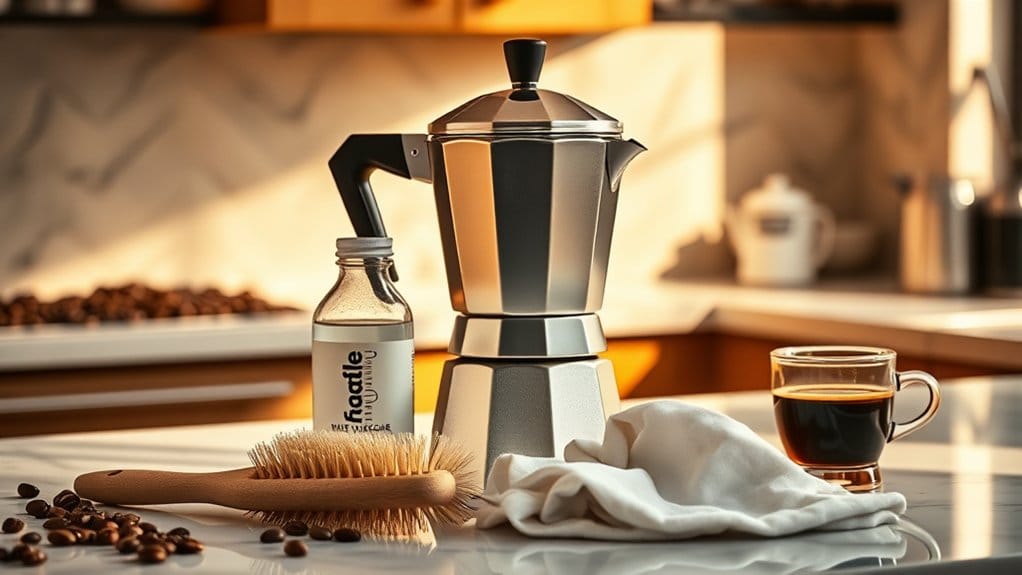
To keep your Moka pot in tip-top shape, clean it right after each brew. Give it a good rinse, avoiding soap, and use a soft brush for stubborn spots. Once a month, deep clean with a vinegar solution to tackle mineral deposits. Watch for slow brewing or strange tastes—it’s time to descale. Store it dry and dust-free, and you’ll have perfect coffee every time. Curious about more tips? There’s definitely more ahead!
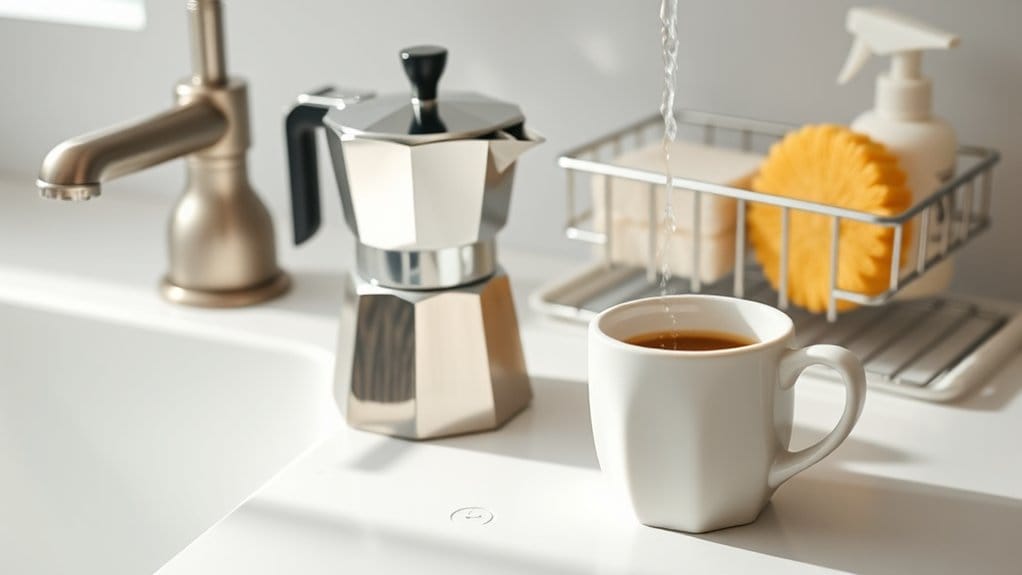
Cleaning your Moka pot right after each use is a significant improvement for both taste and hygiene.
Think about it: you want that delicious coffee flavor to shine, right? Start by tapping out those coffee grounds into the bin; it’s like giving your pot a fresh start!
Next, wait until it cools down before disassembling it—don’t burn your fingers! Rinse each part with warm water, making certain to avoid soap. Those coffee oils cling on for a reason! Regular maintenance of your pot can help prevent bacteria buildup and keep your coffee tasting great.
Use a soft sponge and a toothbrush to gently reach the nooks and crannies. You’ll be surprised at what can hide there. Regular cleaning helps preserve delicious coffee flavor and maintain the moka pot’s longevity ensures a great brew every time.
Finally, let all parts dry completely; nobody wants a moldy Moka pot! Consistent care makes every brew taste better.
Every month, it’s a good idea to give your Moka pot a thorough deep cleaning to tackle those troublesome mineral deposits. Cleaning your Moka pot regularly ensures safety by minimizing the risk of pressure build-up from clogs, which can lead to greater issues. These annoying buildups can show up after using hard water and could clog your safety valve. Regular checks of the pressure release valve are essential for safe operation.
Start by preparing a vinegar solution, mixing equal parts of water and white vinegar. Soak the bottom chamber and filter for 15–20 minutes, but remember, don’t soak the rubber gasket!
After soaking, grab a soft brush and gently scrub away any visible stains. Rinse everything well under running water, ensuring no vinegar lingers. Once clean, reassemble your pot and run a brew cycle with just water—this flushes out any leftover flavors.
Now you’re ready to enjoy your coffee without any funky aftertastes!
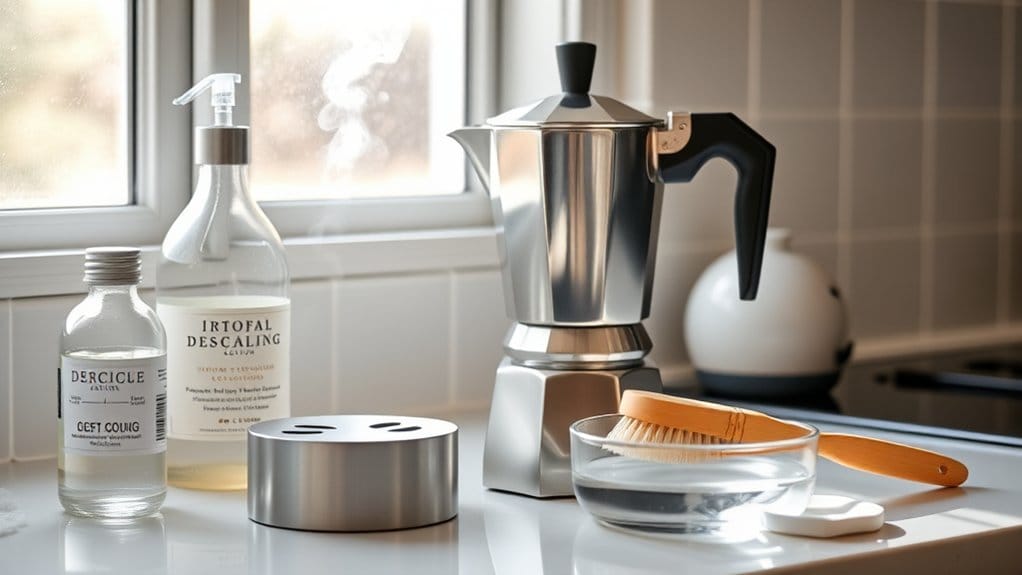
When you notice your coffee is taking longer to brew, it might be time to check for scale buildup in your Moka pot.
Slower water flow and brewing times can indicate those troublesome mineral deposits are getting in the way. If your coffee starts tasting bitter or metallic, that’s a big red flag!
You might even hear some unusual sounds during brewing—like your pot’s trying to sing a sad song. Regular descaling is essential for maintaining coffee quality and preventing scale buildup that affects performance.
To keep your Moka pot happy, descale it monthly if you live in a hard-water area, or every three to four months if the water is soft.
Regular descaling is like giving your Moka pot a spa day, helping it brew the best coffee possible!
Don’t let scale steal your morning magic!
You might be excited to brew your first cup with a Moka pot, but taking a moment to clean it before using it’s a must.
First, disassemble your pot into three parts: the top chamber, filter basket, and bottom water chamber. Don’t forget to carefully remove the rubber gasket and metal filter.
Give everything a good scrub with a soft sponge and mild dish soap. Rinse thoroughly with warm water—no harsh cleaners allowed!
Next, assemble it back together and run one or two cycles with just water. This helps eliminate any weird metallic tastes that might sneak in.
After all that, a good rinse guarantees your coffee tastes fabulous on brew day. So, let’s get to it!
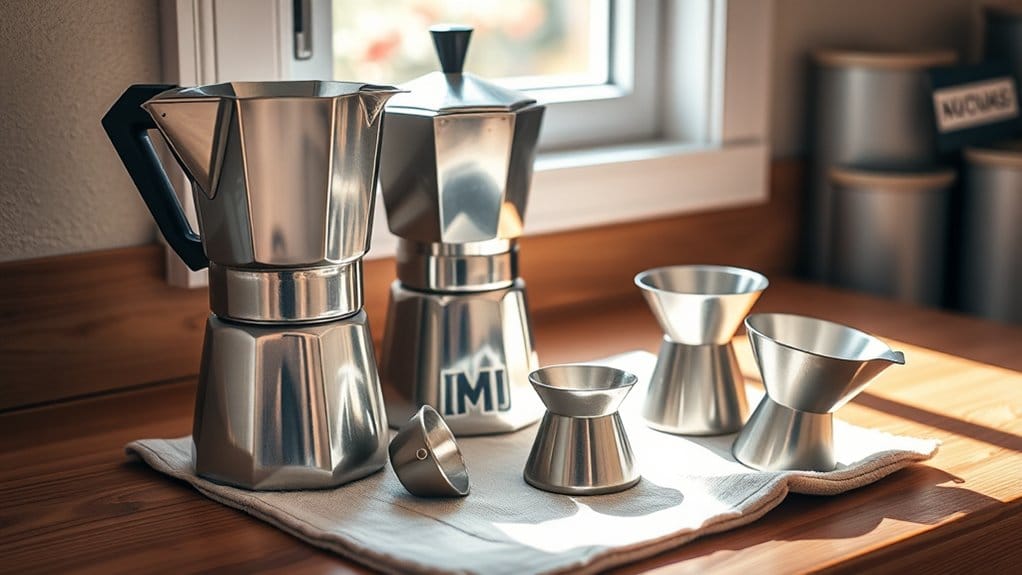
Drying your Moka pot properly is just as important as cleaning it. A well-dried pot prevents rust and keeps that shiny appearance intact.
Grab some paper towels or a soft cotton dishtowel to quickly wipe off any wetness; it’s like giving your pot a cozy towel hug!
Air drying the parts separately is ideal for long-term storage, whereas avoiding direct sunlight to prevent warping.
Store your Moka pot in a clean, dry spot, away from heat. A dust cover or sealed container helps keep it pristine.
Remember, wetness doesn’t just affect flavor; it can additionally lead to mold.
So, treat your Moka pot with care, and it’ll reward you with delicious brews for years.
Happy brewing!
Cleaning your Moka pot can be a delightful experience—after all, it’s the key to brewing that perfect cup of coffee!
But safety is crucial. First, always let your pot cool before cleaning. You don’t want a surprise burn, right? Remember, no dishwashers! Abrasive sponges are a big no, too; they can scratch your lovely aluminum.
Check that safety valve—it’s the heart of your pot. If it’s clogged, it could cause a mini-explosion. Always use mild soap and avoid harsh cleaners. Clear any blockages with a soft brush.
Finally, ensure to store your pot in a dry place, so it stays rust-free. With a little care, you’ll keep brewing delicious coffee without any hiccups!
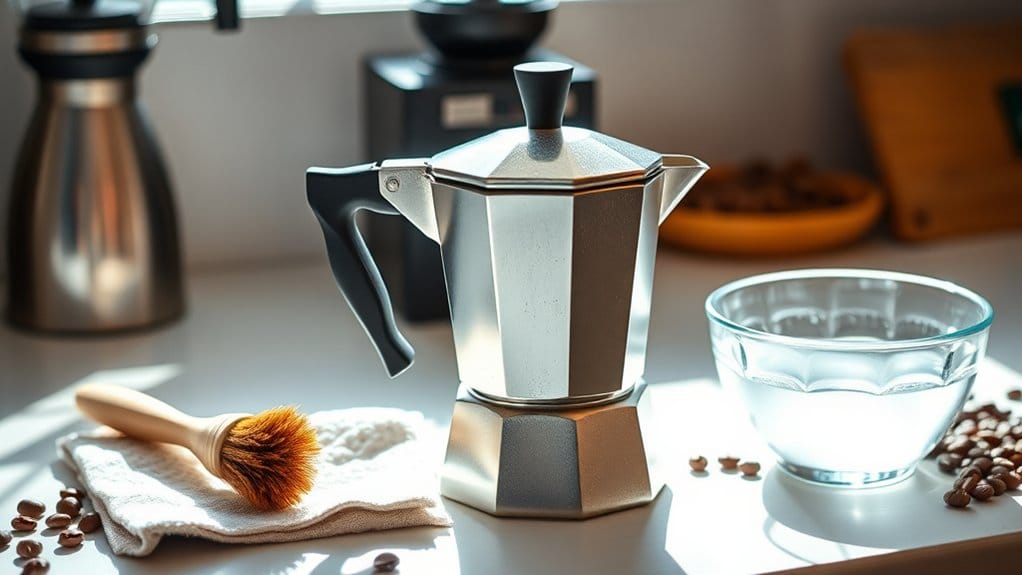
After making certain your Moka pot is safe to clean, it’s time to gather the right tools for the job. You’ll want quality coffee brushes and soft scrubbers to tackle those stubborn grounds. These won’t scratch your precious pot, promise!
Don’t forget pipe cleaners for those tricky spouts—nobody likes a clogged coffee maker.
A microfiber cloth helps dry and shine your Moka pot, keeping it looking brand new. If you’re dealing with mineral build-up, grab a specialized descaling agent or even some vinegar. Remember, staying away from harsh chemicals is key. Additionally, consistently cleaning your Moka pot ensures rich, flavorful coffee remains a staple in your brewing routine.
Finally, check your rubber gaskets and seals. They need love too! With these tools, your Moka pot will stay in tip-top shape, ready for delicious brews.
You shouldn’t use detergent for cleaning your Moka pot, especially if it’s aluminum. It can alter the flavor and damage the protective coating. Rinsing with warm water and occasional vinegar slips is a better choice.
To tell if your moka pot’s damaged, check for visible cracks, leaks, or excessive wear on the gasket. Listen for unusual sounds during brewing, like sputtering, and watch for coffee grounds in your brew.
When cleaning your moka pot, use soft sponges, non-abrasive cloths, and natural ingredients like baking soda or vinegar. Avoid harsh chemicals and scrubbing pads to keep your pot in great shape and avoid scratches.
It’s typically not safe to use a dishwasher for Moka pot parts. High temperatures and harsh detergents can damage gaskets and finishes. Stick to manual cleaning methods for longevity and better maintenance of your coffee maker.
To improve your brewed coffee, focus on grind size, brew time, and water temperature. Experiment with different methods, adjust coffee-to-water ratios, and pay attention to freshness for a balanced and delightful flavor experience.